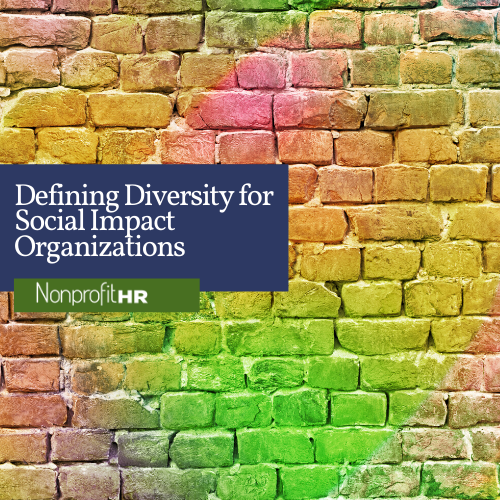WTOP: 5 ways nonprofits can…
As the job market improves, turnover is on the rise at most nonprofit organizations. In fact, 19 percent of the nonprofits surveyed in our 2015 Employment Practices Survey said they experienced turnover in the previous year, up from 16 percent in 2014. If our early 2016 data is any indication, this trend will only grow in the year ahead.
Today, standout job seekers are finding themselves with more options and offers than ever before, and nonprofits are facing unprecedented competition for top talent. Landing a highly competitive candidate offers a big boost to your organization, but then the real challenge begins–engaging and retaining your new employee. The costs of failure are high. In fact, a recent article from The Wall Street Journal claims it costs upwards of twice an employee’s salary to recruit and train a replacement.
For many nonprofits, a compensation-based retention strategy isn’t the answer, and offering non-traditional benefits like flexible scheduling and location independence won’t convince most employees to stay either. After all, these offerings have become commonplace, and therefore do little to set your organization apart. If you really want to get ahead of the curve when it comes to retention, consider these strategies instead:
Hire Smarter
Retention begins with recruitment. Poor hiring decisions will result in high turnover rates no matter how forward-thinking your retention strategy may be. When a client comes to us and asks us to help solve a retention challenge, their hiring practices are always the first thing we evaluate. Some of the questions we ask include:
- Is recruiting an integral part of your organization’s culture? Organizations that truly excel at recruitment engage everyone, from entry-level employees to executives, in sourcing and vetting talent. There is no better example of the power of this practice than the one set by Google. After years of research and data mining, the company determined that candidates referred by existing Google employees make the best hires. Google initially implemented a referral bonus program to incentivize employee involvement in recruiting, but when it proved ineffective, they instead turned to culture development and internal communications to drive referrals. Today, Google has come to understand that building a company that their employees love to work for and then simply nudging them to make recommendations when positions open up is the best way to encourage high quality internal referrals.
- Is your interview process providing an accurate assessment of your candidates’ potential? Research literature indicates that unstructured face-to-face interviews are a poor predictor of eventual job performance, yet most organizations still rely on this interview format as their primary means of vetting candidates. Here, too, Google has broken the mold and excelled. According to Laszlo Bock, Senior Vice President of People Operations at Google, the organization has found success in “combining behavioral and situational structured interviews with assessments of cognitive ability, conscientiousness and leadership.” The company has even created a digital tool to help hiring managers select the best interview questions, skills tests and other tools for each opening. While your organization may not have a recruitment budget that matches Google’s, you can still improve your interview process by structuring a series of diverse evaluations that go beyond standard face-to-face interviews.
- Are you screening for mission alignment? In the nonprofit sector, mission alignment can be as important as skills and aptitude. Follow the example set by anti-poverty nonprofit CAP Tulsa, an organization that prioritizes candidates’ passion for their cause.“We start with an initial hiring process that screens for job-related technical knowledge, and also consider whether a candidate shares our belief in our mission,” CAP’s Executive Director Steve Dow explained in a recent NonProfit Times interview. “That is reinforced by our onboarding process, which grounds new employees in our organizational mission, strategy and the expectations that the organization and employees have of each other.”
Make Onboarding Count (and Go Beyond the Basics)
According to a recent study conducted by Aberdeen Group, 90 percent of employees make a decision to stay at an organization within their first six months on the job. Onboarding is one of the most crucial times in an employee’s tenure with your organization, and yet only a third of employers have a formal onboarding strategy.
In the nonprofit sector, it’s especially important to structure your onboarding process to address the unique skills and competencies your new hires will need to work with the population you serve. No organization does this better than the Wounded Warrior Project, a nonprofit that works with returning service members. WWP’s three-day onboarding process goes beyond general new hire orientation activities and includes things like suicide prevention training and hands-on discussions with returning service members about post-traumatic stress disorder. These activities are mandatory for all new hires, not just direct service employees.
Involve Employees at All Levels in Decision-Making and Performance Management Practices
A study by Peter Barron Stark Companies found that there is “a direct correlation between how involved employees are in … decision-making and their overall morale, motivation and satisfaction with their jobs,” and organizations like General Mills, DonorsChoose and DoSomething have all discovered innovative ways to involve their employees in their decision-making process. For example, General Mills makes discussions about the future of their company a standard part of every employee’s performance review. Managers are trained to encourage staff at all levels to offer ideas for innovation and opinions on crucial company decisions.
The New York City-based nonprofit DoSomething has taken this approach a step further, hosting weekly innovation meetings every Wednesday where all employees are invited to present and explore new ideas for the organization, no matter how off the wall they may be. And school fundraising nonprofit DonorsChoose uses a diffused decision-making model through which leadership gathers and acknowledges the opinions of employees at all levels when making important management decisions.
You can even consider giving employees the opportunity to get involved in structuring their own performance reviews. The National Older Worker Career Center (NOWCC), which was ranked number one overall for the second straight year in the NonProfit Times Best Nonprofits To Work For list, recently revamped its performance evaluation process with the guidance of several employees at different levels. According to the NonProfit Times, these employees not only helped design the new program, but also “explained it to colleagues, so folks would understand that it is focused on helping every member of the staff improve their professional development.”
Consider Sabbaticals
Believe it or not, your nonprofit has a lot to gain by encouraging your staff to work less. Sabbatical programs are gaining popularity at for-profit companies, and the nonprofit sector is not far behind. IBM’s sabbatical program, which encourages employees to take an eight-week sabbatical after seven years at the company, is often touted for its impact on employee retention and engagement. DoSomething recently took a page out of IBM’s book, but put a unique mission-aligned spin on their approach. DoSomething offers a month-long sabbatical to all employees who have been with the organization for at least two years. The only requirement is that the time off must be used to volunteer. With a full 30 percent of employees in a recent survey citing an ability to take extended time off as a key factor that would improve their likeliness to stay in a job, this unconventional retention strategy is one you shouldn’t ignore.
Build an Effective Staff Acknowledgement Strategy
Many employees value praise and acknowledgement far more than pay. Rather than defaulting to a tired “employee of the month” program, take a page out of Intuit’s book and implement an online recognition and rewards system that gives employees instant, organization-wide praise and rewards for a job well-done. According to a case study from Stanford Business School, Intuit’s rewards program resulted in a sustained double-digit increase in employee engagement among the over 8,000 employees who participated in the program. Nonprofit organization,
You don’t have to invest in expensive technology to implement an effective program, either. Nonprofit organization StepUp has seen its own success with a staff acknowledgement strategy that focuses on routine personal acknowledgement from management of both work-related achievements and important life events like staff birthdays and wedding anniversaries. Handwritten cards and personal congratulatory announcements are central to their approach. It’s not high-tech, but it works. That’s because StepUp’s management takes the time many leaders do not to recognize and connect with their employees.
If you’re ready to get serious about improving your organization’s retention rates, begin by evaluating which of these strategies are likely to resonate most with your employees, and then start testing them out. Your staff should quickly notice the efforts you are making to show them your appreciation and improve their experience at work. Then, to get a more concrete sense of how your employees are responding to your retention efforts, consider conducting retention interviews. Download our free e-book, 15 Questions to Ask in a Retention Interview, to start planning your own interviews today.
About the Author
Carla Mazique is a Senior HR Business Partner at Nonprofit HR with over 25 years of experience spanning the private and nonprofit sectors including holding key management and consulting positions with a Fortune 500 company. Prior to joining Nonprofit HR, Carla served as Director of Human Resources with the International City Management Association (ICMA) for over 20 years and with Merrill Lynch in various capacities relocating to Georgia, Connecticut and New Jersey. At Nonprofit HR, she leads retained and project-based engagements focused on helping nonprofits strengthen their missions through their people.





























